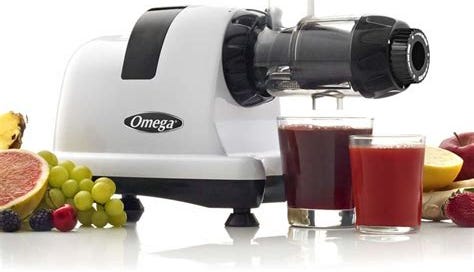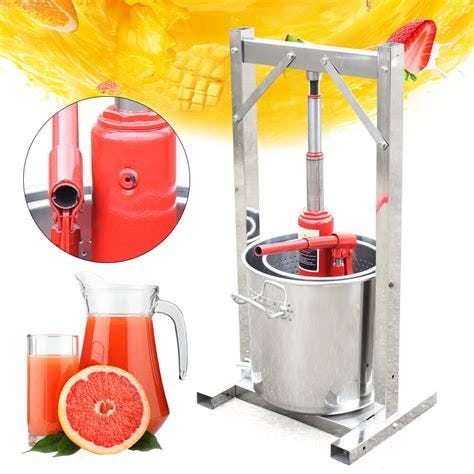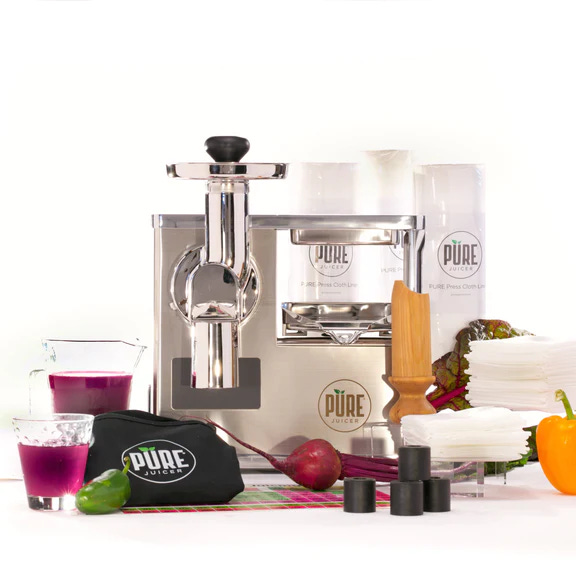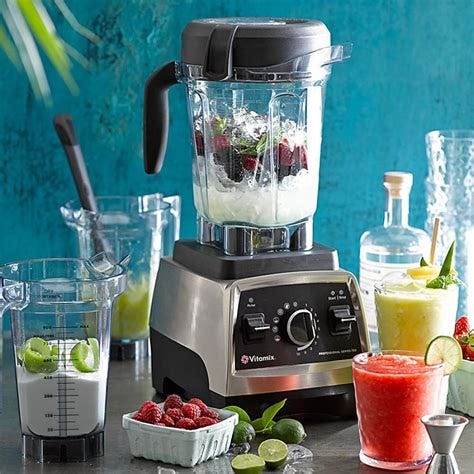Juice can be made using a manual press or a more sophisticated machine that either masticates or uses centrifugal force to extract.
The most familiar manual press is a very simple citrus juicer.
A step up from this type of juicer is one where the pressure is applied by a lever rather than the wrist!
The next level up would probably be the type of press used by herbalists. Many herbs are extracted in liquids such as vinegar, wine or stronger alcohol, glycerin, water, or oil. The liquid is called a menstruum, and the herbs are sometimes extracted quickly in hot water or slowly over a period of weeks or months in the menstruum.
The hot water extraction may be a tea, aka infusion, or a preliminary step to another extraction, perhaps using a different solvent. At the perfect time, the mixture can be strained or pressed, depending on the herbs used. At home, one might find a coffee press perfectly adequate, but if extracting larger quantities, a more serious press is needed.
The famous Norwalk juicer was recommended for Gerson therapy. The main contender now seems to be Pure. It is a cold press juicer, very pricy, and uses only pressure, no grinding or spinning. Pulp can be composted or sometimes made into some sort of pancake or baked good.
Smoothie Blenders
Most people are familiar with smoothies. They are usually made in a blender. These vary from battery-operated portable models to very sturdy industrial models. For home use, there is little doubt but that the Vitamix model is about as close to top of the line as one can get.
Smoothies contain everything put into the blender, including all the fiber and bits of whatever ingredients are used to make the smoothie. Many people like the thick, rich taste and feel of smoothies, especially if they add something that is perhaps not quite so healthy, like ice cream . . . but I sometimes make my own ice cream, and it is totally digestible and healthy.
Juicers
Real juicers separate the pulp from the liquid. Besides the hydraulic type presses, there are basically two other types, but they “grind” instead of pressing.
Masticating juicers operate more slowly and do not force as much oxygen through the fruits and vegetables. Therefore, there is less oxidation. Centrifugal juicers spin much faster and use special blades. These often have convenient features that expel the pulp. Centrifugal juicers are generally less expensive than masticating juicers. They are also usually easier to clean, but they extract less juice; and the juice tends to oxidize more quickly.
It might be timely to mention that Rudolf Breuss authored a best selling book on juicing as a cure for cancer. He advocated straining the juice so that almost no pulp was ingested.
For the record, his theory was that tumors require protein for growth and that depriving them of protein for 42 days will cause the death of the tumors. I know many people who have followed his protocol and others who were cured after going on a grape and grape juice fast. Many follow the Gerson diet which relies heavily on carrots, which for the record are in the same plant family as cilantro. Others use a mixture of either fruits or vegetables.
For home use, I lean towards masticating juicers. Over the long haul, the higher price is justified by the superior extraction, i.e., more juice from the same amount of fruits and vegetables. Popular brands that can be considered are Champion and Omega, but I suggest reading reviews and coming to your own conclusion about what to buy.
Some juicers are noisy and vibrate a lot. They need a stable counter and should be monitored, not left on autopilot.
Most of the juicers are produced in China or Korea. The same company may provide models made in either country. In general, the Korean models seem to have a better build quality. Many have 10-year warranties.
Wheatgrass
Many people love wheatgrass, but it generally uses slightly different equipment for extraction.
The juice has a quite memorable taste and it often generates a real buzz. Wheatgrass contains many nutrients, especially chlorophyll. It is an antioxidant and can be added to a smoothie or juice, but the extraction method is a little different. Moreover, the wheatgrass is usually grown at home though some delivery services are available for patients who have been prescribed special dietary protocols.
This information is presented in an informal manner to help people to get started with juicing. I do not sell juicers and have not ever received any compensation from any manufacturer. These are therefore my own opinions and stem from half a century of guiding people through their healing processes.
The next post is also free and will cover sprouting and growing some of one’s own food indoors or in a greenhouse — or climate permitting — in the garden. My intention is to help people to make decisions when the topics are new and perhaps confusing.
Posted by Ingrid Naiman on 20 January 2023 || All Rights Reserved










